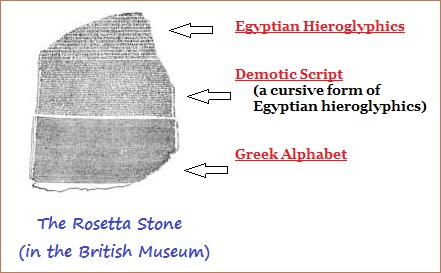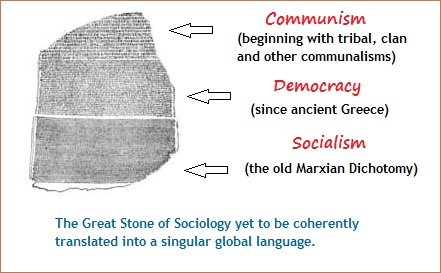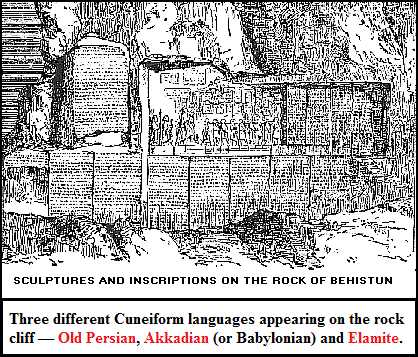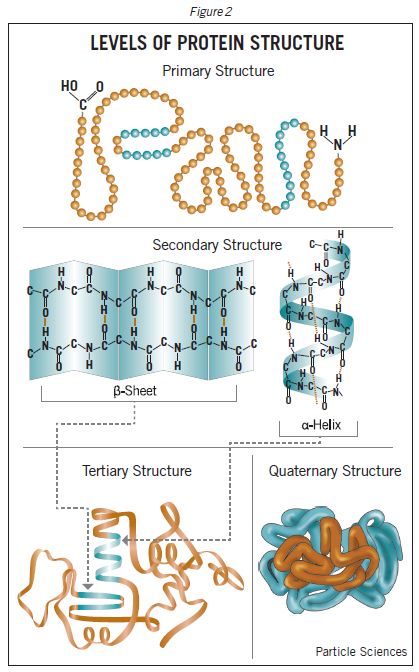page 2
Let us begin this page by referencing a well know constituent of biological chemistry (or generally speaking, biology) known as DNA (deoxyribonucleic acid)... though its complementary counter-parts RNA (ribonucleic acid) and Proteins can and will be mentioned as well. Apparently, because DNA is present in as many different life forms that have been analyzed, DNA is considered to be a universal constituent. (In simpler terms, since it is is found again and again in different forms of life, it is considered to be a basic requirement.) Coincidentally, as some might want to point out, its underlying triplet codon (coding) system is likewise an important "signal", personality or physiology. And when we find that RNA has the same type of coding system... except that it has a preference for the amino acid Uracil while DNA's preference is for Thymine. If we put the structures together in a simple illustration, we come up with a very interesting pattern that not only shows a recurring "three" as a nature-born type of dialectic, so-to-speak... but its configuration is of a logical structure which humanity has only been toying with with unsophisticated philosophical formulas:
| ~ Item ~ | ~ Three the same ~ | ~ One is different ~ |
| DNA = | Adenosine- Cytosine- Guanine | Thymine |
| RNA = | Uracil |
Amino acids are the building blocks of Proteins. In other words, there an increasing complexity in protein structure beginning with simpler amino acid formulations. An analysis of such exhibits a "three" pattern as well as a 3 -to- 1 configuration labeled with references which enable us to identify a similarity of pattern. For example, when we use the word "Primary" along with the word "Secondary", the numerical values of "1" and "2" are readily accepted as acceptable alternatives. Likewise when we encounter the words "Tertiary" and "Quaternary" in the same context. While some may prefer to use "three", and "four", this is only because they have not been introduced to the idea of a "3 -to- 1" ratio... even if it is introduced as a pattern that might be of value to consider when the information is applied to a larger context involving multiple forms of information from different subject areas.
Without such a (3 -to- 1) reference being used as a commonality of consideration in pattern recognition, the wide-spread global grade school training of 1,2,3,4, etc., is a commonly executed formula of labeling and thinking. We are not taught to think in terms of seeking out patterns in multiple subject areas that may or may not conform to already accepted patterns of alignment and by using conventional systems of language, definition, grammar, and associated definitions. Accepted ideas can get in the way of progress. We don't think or speak like early hominids because their language and cognitive associations are limitations. Though valuable that they might be in terms of identifying pristine forms, the primitivity of their language would prohibit application onto other subjects unless the words and language used for those subjects had a usable translation upon which to structure more complex appreciations.
In our current system of teaching and learning "our numbers, letters, colors and basic forms of politeness", the elementary sequences of 1...2...3, etc., and A...B...C, etc., are accepted as both rational and logical. The usage of Mathematics as a translation devise, permits us to apply simple numbers into complex arrangements from which the ideas of algebra, geometry, trigonometry, calculus, etc., are derived. Thinking in terms of a 3 -to- 1 ratio appearing in different guises in different subjects, is not a current form of interpretation because it is a different type of unfamiliar language that can be used as a simple means of communication amongst different subjects like a lingua franca developed amongst speakers of different languages in order to facilitate communication, of which our present day languages attest to because of a common ancestry. Marx's attempt at establishing a "Scientific Socialism" was a method of unveiling what he perceived to be as a common ancestry of social activity that was repeated in successive generations. The succession of repetition suggested to him that progress was associated with greater complexity all of which related to an underlying equation which would inevitably result in a give conclusion called Communism. And because of this assumed result, it was not only natural, but a Right that humanity skip over intervening developmental processes and begin the practice in order to do away with all the needless trial and error forms of intervening social structures.
Unfortunately, Marx did not take into consideration enough information nor realize the scale of time that was involved. Nor did he carry the equation over onto two other chalk boards, like many an instructor has found the need for in their classrooms. The limitation of his own mortality no doubt influenced the contour of his logic into a truncated version of a much larger equation needed for a more comprehensive decipherment of human socialization. For example, while it is thought by some that Communism, Democracy, and Socialism represent sequences of social development leading from the more primitive to the more complex or from worse to better or whatever dichotomy is preferred), regardless of how these three may be arranged according to the disposition of a given thinker; it is not customary for these words to be attributed with numerical symbols such as 1,2,3... because the usage of number labels generally take on an associated quantitative reference as well. In other words, it is difficult for some to see a number symbol without relating it to a particular quantity.
While the usage of numbers, as symbols, can be applied as a means of labeling value, this value does not then need to be associated with a quantity. Placement in a sequence does not necessarily have to relate to value that is then equated to a number, since generality can sometimes be better used as a denominator of commonality that is more serviceable to a larger application. In other words, identifying three items and then labeling them in a numerical sequence is not an observation meant to say in which numerical order these ideas should be placed such as those claiming Communism is the most advanced social order to be achieved, and should therefore be in a presumed 3rd and thus more advanced position. The usage of number in this instance is a means by which the three can be sequenced as a group... representing but one variable amongst multiple others to be similarly found in different subjects; if we can arrive at the usage of a common language for comparing the information in different subjects. It is of little value to try to barter the value of one's idea(s) if our individualized semantics prevents us from effectively communicating.
Analogously, in some metaphorical sense, Communism, Democracy and Socialism are like the "three languages model" inscriptions found on the Rosetta Stone, Behistun Rock, and the Galle Rock. Let me provide illustrations of these and then use the Rosetta stone image to represent the three social ideologies as if they are languages needing to be coherently translated:
 |
 |
 |
 |
While trying to establish a common language in order to effectively translate information to be derived from different subjects is difficult enough, if we then try to assert that what has thus been uncovered is a pattern associated with a similarly identifiable environmental pattern and that this is a pristine influence, additional systems of logic may be placed on trial because of committing perjury. In other words, they have lied to us and we must reexamine the evidence. The faultiness of such evidence caused Marx to reach the wrong verdict about humanity's role in its own sociological development. Hence, let us continue with the introduction of biological evidence for our case by adding a simplified perspective of Protein structure... but not overlooking the fact that proteins are both species and organ specific, and that they are the result of many amino acids linked together. In other words, there is an easily established cause and effect. And it should also be pointed out that simple plant structures can synthesize all their needed amino acids while more physiologically complex humans can not, and thus need to get the necessary means for doing so, from nourishment such as food sources. Unlike plants getting nutrients through the Sun and Soil (and atmosphere), the digestive properties is a bit more complex than simply photosynthesis.
| Item | --- Three the same --- | --- One is different --- |
| Protein = | Primary structure- amino acid sequencing [linear] Secondary structure- overlapping (folding/coiling [circular] Tertiary structure- three dimensional [triangular] |
Quaternary structure as a composite of the first three |
| Increasing 3 -to- 1 ratio complexity in proteins began from the 3 -to- 1 amino acid lineup.→ | ||
Another way of looking at the ensemble is to say that the primary structure is due to an increased complexity of amino acids... The secondary structure is due to an increased complexity of the primary structure... The tertiary structure is due to an increased complexity of the secondary structure. The quaternary involves all three. Yes, we can call this a "four" arrangement and that a "3 -to- 1" is due to a stretched imagination, or we can allow ourselves to be open to the possibility that there is a 3 -to-1 ratio even though we do not at present use the linguistic tools to decipher protein structure research in such a framework. In other words, let's keep the present formula in mind as being another form of the 3 -to- 1 ratio.
 Particle Sciences®
Particle Sciences® |
 Difference Between Primary and Secondary structure of Protein
Difference Between Primary and Secondary structure of Protein
|
It is appreciated that the notion of a "3 -to- 1" ratio may be difficult for some readers to get their heads around the notion since they may neither have a familiarity with protein structure and are uncertain as to how such an example fits into a discussion of Sociology that typically resorts to the analytical methodology of using purely overt human relationships and does not include developmental precursors involving basic biological materials. But without including patterns existing in biological substrates, we are failing to provide a deeper dissection of historical conditions which play a part in the Sociology of human development. So let us attempt another way of presenting the assessment of protein structure by the usage of simple number alignments:
- Primary structure = 1. {amino acids + amino acids}.
- Secondary structure = 2. {Primary + Primary}
Tertiary structure = 3. {Primary + Secondary} - Quaternary structure = (6!) {Primary + Secondary + Tertiary}
- Secondary + Secondary ≠ Tertiary structure.
- {Tertiary + Tertiary ≠ Quaternary structure}.
- Using basic math: [1 + 2 + 3 = 6... it does not equal "4"].
The "6" is not congruent to the 1,2,3 sequence, where "4" would follow suit. Therefore, in this example, it represents a different type of "personality". A way to understand this "personality difference" is to relate the overall difference to another "3 -to- 1" example that may be more familiar to some taken from the New Testament biblical tradition. When we confront the 4 accounts of Matthew, Mark, Luke and John, it is noted that the first three are referred to as "Synoptic" and the latter one (John) is labeled idiosyncratic, because three of the accounts are particularly similar and one isn't. Here is a reference from the Britannica:
Synoptic Gospels: The Gospels of Matthew, Mark, and Luke in the New Testament. Since the 1780s the first three books of the New Testament have been called the Synoptic Gospels because they are so similar in structure, content, and wording that they can easily be set side by side to provide a synoptic comparison of their content. (The Gospel of John has a different arrangement and offers a somewhat different perspective on Christ.) The striking similarities between the first three Gospels prompt questions regarding the actual literary relationship that exists between them. This question, called the Synoptic problem, has been elaborately studied in modern times. "Synoptic Gospels." Encyclopædia Britannica Ultimate Reference Suite, 2013. |
Here's a reference from the Wikipedia:
The gospels of Matthew, Mark, and Luke are referred to as the Synoptic Gospels because they include many of the same stories, often in a similar sequence and in similar wording. They stand in contrast to John, whose content is comparatively distinct. The term synoptic (Latin: synopticus; Greek: συνοπτικος, translit. synoptikós) comes via Latin from the Greek συνοψις, synopsis, i.e. "(a) seeing all together, synopsis";[n 1] the sense of the word in English, the one specifically applied to these three gospels, of "giving an account of the events from the same point of view or under the same general aspect" is a modern one. This strong parallelism among the three gospels in content, arrangement, and specific language is widely attributed to literary interdependence. The question of the precise nature of their literary relationship—the "synoptic problem"—has been a topic of lively debate for centuries and has been described as "the most fascinating literary enigma of all time".[3] The longstanding majority view favors Marcan priority, in which both Matthew and Luke have made direct use of the Gospel of Mark as a source, and further holds that Matthew and Luke also drew from an additional hypothetical document, called Q. Broadly speaking, the synoptic gospels are similar to John: all are composed in Koine Greek, have a similar length, and were completed within a century of Jesus' death. And they differ from non-canonical sources, such as the Gospel of Thomas, in that they belong to the ancient genre of biography,[5][6] collecting not only Jesus' teachings, but recounting in an orderly way his origins, his ministry and miracles, and his passion and resurrection. In content and in wording, though, the synoptics diverge widely from John but have a great deal in common with each other. Though each gospel includes some unique material, the majority of Mark and roughly half of Matthew and Luke coincide in content, in much the same sequence, often nearly verbatim. This common material is termed the triple tradition... Wikipedia: Synoptic Gospels The Q source (also Q document, Q Gospel, Q Sayings Gospel, or Q from German: Quelle, meaning "source") is a hypothetical written collection of Jesus's sayings (logia). Q is (part of) the "common" material found in the Gospels of Matthew and Luke but not in the Gospel of Mark. According to this hypothesis, this material was drawn from the early Church's Oral Tradition. Along with Markan priority, Q was hypothesized by 1900, and is one of the foundations of most modern gospel scholarship.[4] B. H. Streeter formulated a widely accepted view of Q: that it was written in Koine Greek; that most of its contents appear in Matthew, in Luke, or in both; and that Luke more often preserves the text's original order than Matthew.
Some scholars have postulated that Q is actually a plurality of sources, some written and some oral. Others have attempted to determine the stages in which Q was composed. Q's existence has been questioned. Omitting what should have been a highly treasured dominical document from all early Church catalogs, its lack of mention by the early Church's fathers is a conundrum of modern Biblical scholarship. But copying Q might have been seen as unnecessary as it was preserved in the canonical gospels. Hence, it was preferable to copy the Gospels of Matthew and Luke, "where the sayings of Jesus from Q were rephrased to avoid misunderstandings, and to fit their own situations and their understanding of what Jesus had really meant". Despite challenges, the two-source hypothesis retains wide support... Wikipedia: Q Source |
Another example of a 3 -to- 1 ratio can be seen in the monetary denominations used in some vending machines. Quite often (in America) we find the requirement for using nickels, dimes, quarters, with the sometime added feature of allowing a purchasers to use a dollar bill. The first three are coins while the latter is paper money. And yes, we could simply refer to this as a "four", or compare it to numerous other examples from different subject areas by using a different type of analytical tool that can be applied to Sociological considerations.
Let us now provide a short list of different types of 3 -to- 1 ratios in order to provide evidence for the claim that there actually exists a variety. However, in providing such a list, it must be noted that the "3 to 1" is sometimes displayed as a "3 in 1", such as is exemplified in the statement "three persons in one godhead", as a reference to the Trinity. Nonetheless, the idea of "3 and 1" is being presented:
| 3 | 1 |
| 3 grouped (drumming) beats separated by | 1 emphasized beat (Native American) |
| 3 ordinary dimensions: Length ~ Width ~ Depth | 1 Time dimension |
| 3 fundamental gauge forces: Strong - Weak - Electromagnetic | 1 fundamental non-gauge force: Gravity |
| 3 "even" amino acids: Adenosine ~ Cytosine ~ Guanine | 1 "odd": Uracil (RNA), Thymine (DNA) |
| 3 basic protein structures: Primary - Secondary - Tertiary | 1 composite protein structure: Quaternary |
| 3 (metal) vending coins: Nickels ~ Dimes ~ Quarters | 1 relational (paper) form: Dollar bill |
| 3 numbered potatoes: 1 potato ~ 2 potato ~ 3 potato | 1 un-numbered 4 (child's counting game) |
| 3 numbered bits: 2 bits ~ 4 bits ~ 6 bits | 1 un-numbered: a dollar (cheer-leading) |
| 3 face cards: Kings ~ Queens ~ Jacks | 1 related Ace card (faceless) |
| 3 typically used face cards: Kings ~ Queens ~ Jacks | 1 less commonly used face card: Joker |
| 3 rhymes: eeny ~ meeny ~ miney separated by | 1 (mo) of another 3: (mo ~ toe ~ go) |
| 3 indoor coverings: Curtains ~ Blinds ~ Shades | 1 related outdoor: Shutters |
| 3 God labels: He ~ She ~ It | 1 relational: Non-Entity (non-existence?) |
| 3 numbered bases: 1st ~ 2nd ~ 3rd related to | 1 unnumbered: Home plate/base |
| 3 customary years | 1 relational: leap year |
| 3 primary internal combustion engine cycles: Intake ~ Compression ~ Power | 1 relational: Exhaust |
| 3 "element" A-U-M = "OM" |
1 relational: Silence |
| 3 step shampooing: Wet hair ~ Lather ~ Rinse | 1 relational: Repeat as desired |
| 3 female desires for a man: Tall ~ Dark ~ Handsome | 1 relational: Rich |
| 3 part call: Hear Ye! Hear Ye! Hear Ye! | 1 relational: The court is now in session |
| 3 part game call: Apples ~ Peaches ~ Pumpkin Pie | 1 relational: Who's not ready hollar I |
| 3 basic forms of matter: Solids ~ Liquids ~
Gases |
1 relational: Plasma |
| 3 (metrical foot) stressed syllables | 1 relational unstressed syllable |
| 3 guitarists (Beatles): Paul ~ John ~ George | 1 relational drummer: Ringo |
| 3 regular U.S. forces: Army ~ Navy ~ Air force | 1 relational: Marines (Navy Dept.) [Coast Guard = Dept. of Transportation] |
| 3 times repeated cadence: Gimme' (give me) your left | 1 related: Right (military marching) |
| Gimme' your left- Gimme' your left- Gimme' your left----- Right | |
| 3 consonants to (four-letter) Cuss Words | 1 related vowel |
| 3 (numerical) feet: 1 foot + 1 foot + 1 foot equals | 1 related (word): Yard |
| 3 common body crossings: Legs ~ Arms ~ Fingers | 1 uncommon related: Eyes |
| 3 Europeans: D.L. George ~ V. Orlando ~ G. Clemenceau | 1 (U.S.A): W. Wilson (Paris Peace Talks) |
| 3 at-bat chances to run | 1 relational mandatory walk (ball four) |
| 3 microorganism "vats": Rumen ~ Reticulum ~ Omasum | 1 "true" stomach: Abomasum (Ruminants) |
| 3 Hurry! Hurry! Hurry! related to: | 1 Step Right Up (Circus Barker) |
| 3 synoptic gospels: Matthew - Mark - Luke | 1 idiosyncratic gospel: John |
| Trinitarian (3) concept related to | Unitarian (1) concept |
| 3 original musketeers (Athos, Porthos, Aramis) | 1 add-on (d'Artagnan) |
| 3 active brain waves (Alpha, Beta, Theta) | 1 inactive brain wave (Delta) |
| 3 types of cones to the human eye | 1 type of rod to the human eye |
| 3 traditional ice cream flavors: Chocolate, Strawberry, Vanilla | 1 category of multiple non-traditional flavors |
| 3 Piaget operational stages: Pre - Concrete - Formal | 1 [non-operational] sensorimotor stage |
| 3 Basic gaseous biological compounds: |
1 Basic solid compound: |
| 3 rows of outer hair cells (mammalian ear) | 1 row of inner hair cells |
| 3 imagined places: Paradise - Purgatory - Inferno | 1 actual place: Earth |
| 3 common growing seasons: Spring - Summer - Fall | 1 less typical growing season: Winter |
| 3 metal ages: Silver - Bronze/Copper -
Iron [Bronze is an alloy of Copper] |
1 non-metal age: Stone (Was there a bone or stick age?) |
| 3 common alternate milk (with fat) forms: 1% - 2% - Skim | 1 common standard form: Whole milk |
| 3 interactive identities: i - j - k = | 1 resultant quaternion identity: -1 |
| W. Hamilton's quaternion formula: i2 = j2 = k2 = ijk = -1 | |
| 3 gasoline types: Unleaded - Regular - Premium | 1 Diesel fuel oil |
| 3 non-gasoline fuels: Diesel - Propane - Natural Gas | 1 gasoline fuels |
| 3 Earthly-bound Horsemen plagues: |
1 Heaven/Hell-bound Horsemen plague: |
| 3 (physically labeled) psychosexual stages: |
1 (non-physically labeled) stage: |
| 3 (OK Corral) Earp brothers: Wyatt - Morgan - Warren | 1 (OK Corral) Doc Holiday |
| 3 Stanley Miller Chemical Evolution experiment
gases: |
1 Stanley Miller liquid: |
| Art Maxim Percentages division: |
|
| 3 basic tea types: Black - Green - Oolong | 1 (basic) rare tea type: White |
| 3 basic mathematical operations: |
1 auxiliary mathematical operation: |
| 3 (DNA) bases code for: | 1 amino acid |
| 3 customary laws of Thermodynamics | 1 Zeroth law of Thermodynamics |
| 3 types of bone: Cortical - Compact - Trabecular | 1 relational: Cartilage (pre-bone) |
| 3 U.S. Presidential debates (2004) | 1 relational: U.S. Vice President debate (2004) |
| 3 compulsory schools: Elementary - Jr. High - High school | 1 non-compulsory school: College (or Trade) |
| 3 "human" cartoon characters: Fred - Wilma - Pebbles | 1 animal character: Dino (family pet) |
| 3 "human" cartoon characters: Barney - Betty - Bam Bam | 1 animal character: Hoppy (family pet) |
| 3 "regular" corners to a building | 1 principal Corner Stone to a building |
| 3 foot bones of ancient horses | Fused together to make modern horse hoof |
| 3 at-base runners: 1st base - 2nd base - 3rd base | 1 at-home-plate grand slam hitter |
| 3 "traditional" size proportions: |
1 commercial profiteering size proportion: |
| 3 flexible downs in American football | 1 play it safe or risk it all downs |
| 3 word vulgar expression: God Damn It | 1 (3 into 1) single word vulgar expression: Goddamnit |
| 3 meal options: Sandwich - Sideorder - Drink | called a (1) combo meal |
| 3 single letter blood type designations: A - B - O | 1 double letter blood type designation: AB |
| 3 phase (U.S.) electric service is related to | 1 phase (U.S.) electric service |
| 3 fingers (or one thumb and two fingers) | ...are commonly used to hold 1 pen, pencil or artist's brush |
Where as it was once thought that proteins were the only catalysts (as enzymes) for change and creation of necessary biochemical activity and development (for metabolic reactions), it is now recognized that Messenger RNAs (mRNAs) play a role as an enzyme... and let us venture to suggest that some researchers may even suspect DNA could possibly play a role. In addition, let us point out the other two major RNA forms, bringing the total to three: Messenger, Ribosomal, Transfer (mRNA, rRNA, tRNA). With respect to catalysts for change, Communists and Socialists are more open to introducing innovative activity than are status quo Democrats who view change in the simplistic arrangement of getting their politician of choice to be elected so that they can carry on with the same nonsense as so many before them. Interestingly, as a parallel to catalytic behavior, although are more than 100 amino acids which occur in nature such as in plants, there are only 20 commonly found in most proteins. If we view proteins as Revolutionists, and then view Revolutions throughout history, we note that Revolutions begin with a limited number (conservation) of "free radicals". Yet, it should be pointed out that there also exist those who would try to inhibit the "enzymatic activity" of such radicals, and that there exists a parallel to this in biochemistry: "Noncompetitive inhibition occurs when an inhibitor binds to the enzyme at a location other than the active site. In some cases of noncompetitive inhibition, the inhibitor is thought to bind to the enzyme in such a way as to physically block the normal active site." From the microscopic to the macroscopic, there are similarities of events which occur.
But let us also point out the presence of a duality: "The α-carbon atom of all amino acids, with the exception of glycine, is asymmetric; this means that four different chemical entities (atoms or groups of atoms) are attached to it. As a result, each of the amino acids, except glycine, can exist in two different spatial, or geometric, arrangements (i.e., isomers), which are mirror images akin to right and left hands. These isomers exhibit the property of optical rotation referred to as dextrorotatory (right) and levorotatory (left), which have parallels in political activity. And even though some may be humored by the correlations, the existence of similar patterns may suggest more than just a coincidence. They may in fact suggest a sort of replication whose correspondences are not well understood, so they are dismissed as having no further relevance for consideration except to extract simplistic comparisons. Serious social thinkers do not necessarily like to think that the ideas which they hold may represent little more than some superficial exercise in Sociological thinking, even if such an exercise is labeled "Political Science". The state of today's Political Science is akin to pre-alchemy. This is as silly as Marx's "Scientific Socialism" claims.
Sources:
"Enzyme" and "Protein" (separate articles). Encyclopædia Britannica Ultimate Reference Suite, 2013.
Yet, the "three the same, one is different" notion is not readily appreciated if we were to look separately at either DNA or RNA. Such an apparent distinction requires both to be placed side-by-side in order for us to make the comparison and highlight the existence of such a pattern. However, once the generalized idea of a "3 to 1" ratio is consciously affixed to our considerations, a list of other examples starts to gain application to various ideas that would otherwise suggest a pattern-of-four to an unsuspecting collector of diverse information, whether or not their research intent is to describe a recurrence that another prefers to use a numerical label in order to record the instance. The 3 to 1 ratio has thus become another cataloging tool that is differentiated from and complementary to a strict "threes" formula.
And though there are other biological constituents that may be looked at such as cell structure, metabolic pathways, etc., more pristine structures, from which other biological activity takes place, helps to serve a reference to biological historical precedents. Let us now turn to physiology where an identifiable "three" pattern can be recognized with a particular emphasis on looking at the cognitive aspect, since a reference to anatomy has already been shown.
Page Initially Created: Monday, 08-Aug-2016... 06:50 AM
Page First posted: Thursday, 11-Aug-2016... 08:08 AM
Updated Page: Sunday, 18-June-2017... 6:29 AM